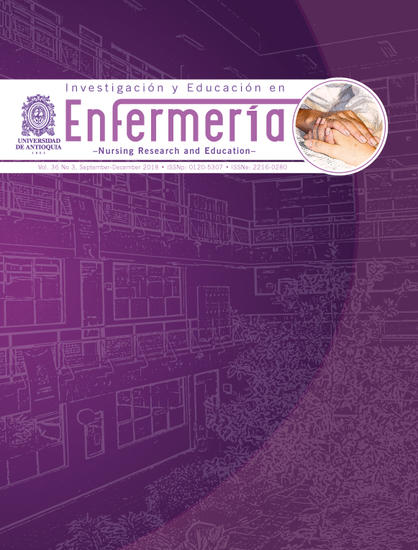Caring for Patients without being with them: Invisibility of Nursing Care in Hospitalization Services
DOI:
https://doi.org/10.17533/udea.iee.v36n3e10Keywords:
Nursing care, hospitalization, nursing staff, hospital, qualitative research.Abstract
Objective This work sought to understand the meaning of invisible care for nurses in hospitalization services.
Methods Qualitative ethnographic study conducted in Medellín, Colombia. Seven open interviews were conducted with an equal number of participants and 30 h of observation. The data was subjected to ethnographic analysis.
Results Two principal categories of analysis emerged: What nurses do and The transformation of the role; the latter with three subcategories (Priorities of the nurses: “What the nurse should do”, Priorities of the institutions: “That which has to be done”, Result of the change: “The unknown nurse”). Nurses during their daily work transform their caregiver role to adapt to diverse demands from the institutional contexts. If they do what they believe they should do, they are invisible to the institutions, but if they do what is visible to the institutions, care becomes invisible to patients and their relatives.
Conclusion In the hospitalization services, nurses care for patients but without being with them. Nurses during their daily work transformed their caregiver role to adapt to diverse demands from the contexts, especially the institutional context.
How to cite this article: Lopera-ArangoAM. Caring for Patients without being with them: Invisibility of Nursing Care in Hospitalization Services. Invest. Educ. Enferm. 2018; 36(3):e10.
Downloads
References
(1) Meleis A. Theoretical nursing. Development & Progress. St Louis: Lippincott; 2012. P.59-81.
(2) Briñez K. Narrativa de enfermería: visión y patrones de conocimiento en una entrevista en el hogar. Rev. Colomb. Enferm. 2014.9:142-48.
(3) Mantzoukas S, Jasper M. Reflective practice and daily ward reality: a covert power game. J. Clin. Nurs. 2004; 13(8):925-33.
(4) Huercanos-Esparza I. El cuidado invisible, una dimensión de la profesión enfermera. Biblioteca Lascasas [Internet] 2010 [cited 26 Mar 2016]; 6(1). Available from: http://www.index-f.com/lascasas/documentos/lc0510.pdf
(5) Balzano S. Visibilidad e invisibilidad de los cuidados en enfermería en una colonia neuropsiquiátrica argentina: una mirada etnográfica. Cuad. Antropol. Soc. 2012; 35:99-120.
(6) Schneider MA, Ruth-Sahd LA. Fundamentos: A vueltas con los pilares básicos del cuidado del paciente. Nursing. 2016; 33(1):48-51.
(7) Urra E, Jana A, García M. Algunos aspectos esenciales del pensamiento de Jean Watson y su teoría de Cuidados transpersonales. Cienc. Enferm. 2011; 17(3):11-22.
(8) Waldow VR, Figueiró Borges R. The caregiving process in the vulnerability perspective. Rev. Latino-Am. Enferm. 2008;16(4):765-71.
(9) Lobato A. La vocación hospitalaria en el cuidado del paciente. Hospitalidad ESDAI. 2014; 39-47.
(10) Wlosko M, Ros C. El trabajo del cuidado en el sector salud desde la psicodinámica del trabajo y la perspectiva del care: Entrevista a Pascale Molinier. Salud Colect. 2015; 11(3):445-54.
(11) Rivera-Martínez MS. El arte de cuidar en enfermería. Horiz. Enferm. 2004; 15:1-13.
(12) Báez -Hernández FJ, Nava-Navarro V, Ramos-Cedeño L, Medina-López OM. El significado del cuidado en la práctica profesional del cuidado. Aquichan. 2009; 9(2):127-34.
(13) Amezcua M. Enfermeras y sociedad ¿son pensables las alianzas? Índex Enferm. 2014; 23(1-2):7-9.
(14) Barker P. The Nature of nursing. In: Barker P. Psychiatric and mental health nursing. The craft of caring. 2nd ed. London: Taylor & Francis Ltd.; 2009. P. 4-10.
(15) Guarín-Berrio GE, Castrillón-Agudelo MC. El mundo de la enfermera: “uno aquí no se sienta”. Contexto de los cuidados. Invest. Educ. Enferm. 2009; 27(2): 226-34
(16) Ortiz-Pommier A. Conflicto de intereses en la relación clínica. Rev. Chil. Neuro-psiquiatr. 2004; 42(1):29-36.
(17) Serrano-del-Rosal R, Ranchal-Romero J. La importancia e invisibilidad de las enfermeras en Atención Primaria de Salud. Index Enferm. 2010; 19(1):9-13.
(18) Boyle D. The Invisibility of Nursing: Implications from an analysis of National Cancer Institute–Designated Comprehensive Cancer Center Web Sites. Oncol. Nurs. Forum. 2010; 37(2):75-83.
(19) Finkelman A, Kenner C. The imagen of nursing: what it is and how it needs to change. Chapter 3. In: Professional nursing concepts. Competencies for quality leadership. 2nd Ed. Burlington: Jones & Bartlett Learning; 2013. P. 85-109
(20) Waldow VR. El cuidado enfermero: una cuestión paradójica. In: Waldow VR. Cuidado de enfermería: reflexiones entre dos orillas. Granada: Fundación Index; 2014. P. 95-132.
(21) Gordon S, Nelson S. An end to angels. Am. J. Nurs. 2005; 105(5):62–9.
(22) Baggio MA, Erdmann AL. The (in)visibility of caring and of the profession of nursing in the relations space. Acta Paul. Enferm. 2010; 23(6):745-50.
(23) Alcaraz-López G, Zapata-Herrera M, Gómez M, Tavera-Agudelo E. Funciones del profesional de enfermería en salas de hospitalización de adultos: tratando de dar cuidado directo. Invest. Educ. Enferm. 2010; 28(1):43-53.
(24) Cifuentes-Rodríguez J, Manrique-Abril F. Satisfacción laboral en enfermería en una institución de salud de cuarto nivel de atención, Bogotá, Colombia. Av. Enferm. 2014; 32(2):217-27.
Downloads
Published
How to Cite
Issue
Section
License
Derechos de propiedad / Direitos de Propriedade
English: If the article is accepted for publication, all copyright will be of exclusive property of Investigación y Educación en Enfermería. The text and the graphics included in the publication are exclusive responsibility of the authors and not necessarily reflect the thought of the Editorial Committee.
Español: Si el artículo es aprobado para publicación, todos los derechos son de propiedad de Investigación y Educación en Enfermería. El texto y las gráficas incluidas en la publicación son de exclusiva responsabilidad de los autores y no necesariamente refleja el pensamiento del Comité Editorial.
Português: Se o artigo for aceito para publicação, todos os direitos autorais serão de propriedade exclusiva de Investigación y Educación en Enfermería. O texto e os gráficos incluídos na publicação são de responsabilidade exclusiva dos autores e não refletem necessariamente o pensamento do Comitê Editorial.















